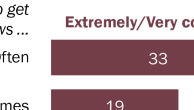
News Media Tracker
Americans now navigate a quickly changing information environment, with a wide variety of news sources across many different platforms and channels. Explore data on how Americans use, trust and distrust 30 major news sources with our interactive tool.
- Accompanying report: The Political Gap in Americans’ News Sources



















